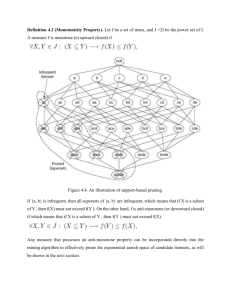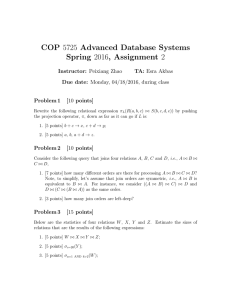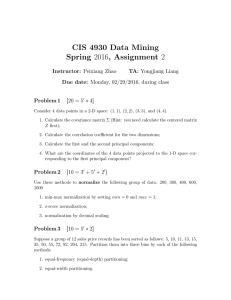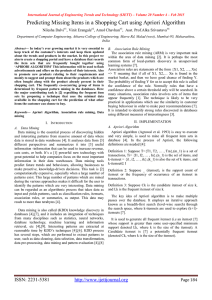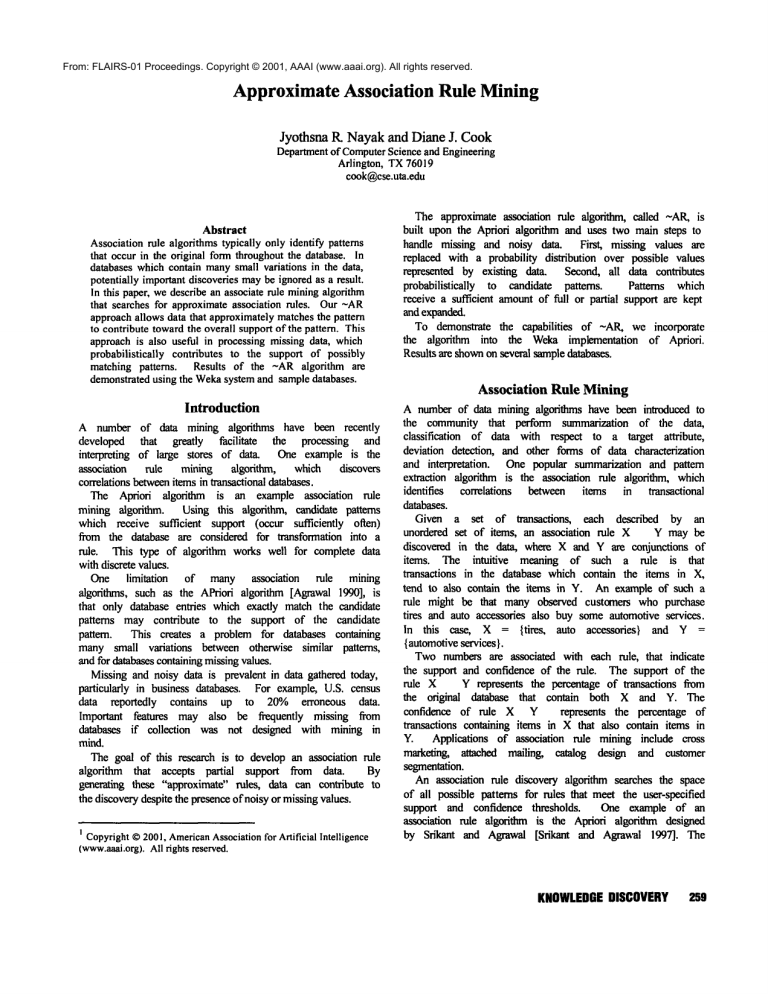
From: FLAIRS-01 Proceedings. Copyright © 2001, AAAI (www.aaai.org). All rights reserved.
ApproximateAssociation Rule Mining
Jyothsna R. Nayakand Diane J. Cook
Departmentof ComputerScience and Engineering
Arlington, TX76019
cook@cse.uta.edu
Abstract
Association rule algorithms typically only identify patterns
that occur in the original form throughout the database. In
databases whichcontain manysmall variations in the data,
potentially important discoveries maybe ignored as a result.
In this paper, we describe an associate rule miningalgorithm
that searches for approximate association rules. Our ~AR
approachallows data that approximatelymatches the pattern
to contribute towardthe overall support of the pattern. This
approach is also useful in processing missing data, which
probabilistically contributes to the support of possibly
matching patterns. Results of the ~ARalgorithm are
demonstrated using the Wekasystem and sample databases.
The approximate association rule algorithm, called ~AR, is
built upon the Apriori algorithm and uses two main steps to
handle missing and noisy data. First, missing values are
replaced with a probability distribution over possible values
represented by existing data. Second, all data contributes
probabilistically
to candidate patmms.
Pattexns which
receive a sufficient amountof full or partial support are kept
and expanded.
To demonstrate the capabilities
of ~AR, we incorporate
the algorithm into the Weka implementation of Apriori.
Results arc shownon several sampledatabases.
Association Rule Mining
Introduction
A number of data mining algorithms have been recently
developed that greatly facilitate
the processing and
interpreting
of large stores of data. One example is the
association
rule mining algorithm,
which
discovers
correlations betweenitems in transactional databases.
The Alm’iori algorithm is an example association rule
mining algorithm. Using this algorithm, candidate patterns
which receive sufficient support (occur sufficiently often)
from the database are considered for transformation into a
rule. This type of algorithm works well for complete data
with discrete values.
One limitation
of many association
rule mining
algorithms, such as the APriori algorithm [Agrawal 1990], is
that only database entries which exactly match the candidate
patterns may contribute to the support of the candidate
pattern. This creates a problem for databases containing
many small variations between otherwise similar patterns,
and for databases containingmissingvalues.
Missing and noisy data is prevalent in data gathered today,
particularly in business databases. For example, U.S. census
data reportedly
contains up to 20% erroneous data.
Important features may also be frequently missing from
databases if collection was not designed with mining in
mind.
The goal of this research is to develop an association rule
algorithm that accepts partial support from data.
By
generating these "approximate" rules, data can contribute to
the discoverydespite the presenceof noisy or missingvalues.
t Copyright©2001,AmericanAssociationfor Artificial Intelligence
(www.aaai.org).
All rights reserved.
A number of data mining algorithms have been introduced to
the community that perform summarization of the data,
classification
of data with respect to a target attribute,
deviation detection, and other forms of data characterization
and interpretation.
One popular summarization and pattern
extraction algorithm is the association rule algorithm, which
identifies
correlations
between items in transactional
databases.
Given a set of transactions,
each described by an
unordered set of items, an association rule X
Y may be
discoverod in the data~ wh~:e X and Y are conjunctions of
items. The intuitive
meaning of such a rule is that
transactions in the database which contain the items in X,
tend to also contain the items in Y. An example of such a
rule might be that many observed customers who purchase
tires and auto accessories also buy some automotive services.
In this case, X = {tires,
auto accessories}
and Y =
{ automotive
services }.
Twonumbers are associated with each rule, that indicate
the support and confidence of the rule. The support of the
rule X
Y represents the percentage of transactions from
the original database that contain both X and Y. The
confidence of rule X Y repres~mts the pel’c~tage
of
transactions containing items in X that also contain items in
Y. Applications of association rule mining include cross
marketing, attached mailing, catalog design and customer
segmentation.
An association rule discovery algorithm searches the space
of all possible patterns for rules that meet the user-specified
support and confidence thresholds.
One example of an
association rule algorithm is the Apriori algorithm designed
by Srikant and Agrawal [Srikant and Agra~al 1997]. The
KNOWLEDGE
DISCOVERY269
problemof discovering association rules can be divided into
twosteps:
I.
Find all itemsets (sets of items appearingtogether in
a transaction) whose support is greater than the
specified threshold. Itemsets with minimum
support
are called frequentitemsets.
2.
Generate association rules from the frequent
itemsets. Todo this, considerall partitionings of the
itemset into rule lea-hand and fight-hand sides.
Confidenceof a candidate rule X Y is calculated
as support(XY)/ support(X). All rules that meet
confidence threshold are reported as discoveries of
the algorithm.
Ll: = {frequentl-itemsets};
k:= 2;
//k represents the pass number
While(Lkq~: O)
Ck= Newcandidatesof size k
generatedfromkk-i
Forall transactionst ~ D
Increment
countof all candidatesin Ck
that are contained
in t
Lk= All candidatesin Ckwith
minimum
support
k = k+l
ReportOkLkas the discoveredfrequentitemsets
k-itemset
Anitemsetcontainingkitems
k
Set
of frequent k-itemsets
(k-itemsets with minimum
support)
Set of candidatek-itemsets
(potentiallyfrequentitemsets)
Ck
Ilk Lk
Setof generateditemsets
Figurei. TheApriodalgorithm.
Figure ! summarizesthe Apriori algorithm. The first pass
of the algorithm calculates single item frequencies to
determine the frequent l-itemsets. Each subsequent pass k
discoversfrequent itemsets of size k. Todo this, the frequent
itemsets Lk-t found in the previous iteration are joined to
generate the candidate itemsets Ck. Next, the support for
candidates in Ck is calculated through one sweep of the
transaction
list.
FromLk-l, the set of all frequent (k-I) itemsets, the set
candidate k-itemsets is created. The intuition behind this
Apriori candidategenerationprocedureis that if an itemset X
has minimum
support, so do all the subsets of X. Thus new
itemsets are created from (k-l) itemscts p and q by listing
p.iteml, p.item2 .... p.item(k-1), q.item(k-1). Items p and
are selected
if items 1 through k-2 (ordered
lexicographically) are equivalent for p and q, and item I~1 i~
260
FLAIRS-2001
not equivalent. Oncecandidates are generated, itemsets are
removed from consideration if any (k-l) subset of the
candidate
is notin Lk.m.
Mining in the Presence of Missing Data
Mining in the presence of missing data is a common
challenge. A variety of approachesexist to deal with missing
data. By far the most common
response is to omit eases with
missing values. Because deleting data with missing values
maywaste valuable data points, missing values are often
filled. Missingvalues maybe replaced with a special symbol
that the mining algorithm ignores. The missing value may
also be induced using standard learning techniques, though
these approachesyield the most successful results whenonly
one attribute is missing [Lakshmiuarayanan1996, Quinlan
1993, Ragel 1998]. Breimanuses a surrogate split to decide
the missing value [Breiman1983]. The surrogate value is the
onewiththe highestcorrelationto the originalvalue.
The most commonapproach is to impute missing values
by globally replacing them with a single value such as the
feature average before initiating the miningalgorithm. The
Wekasystem, on which we implement our ~ARalgorithm,
substitutes the modeof a nominalattribute for missingvalues
throughout
the dam_base.
The -AIR Algorithm
our approach to approximate association rule mining is
embodied in the ~ARalgorithm.
The ~ARalgorithm
represents an enhancementof the Apriori algorithm included
as part of the Wekasuite of data mining tools [Weka]. The
Wekaalgorithms, including the basic Apriori algorithm, are
writtenin Javaandincludea uniform
interface.
The first step of the ~ARalgorithm is to impute missing
values. Each missing value is replaced by a probability
distribution. In order to adopt this approach, we makethe
assumption that fields are namedor ordered consistently
betweendata entries. This probability distribution represents
the likelihood of possible values for the missing data.
calculated using frequency counts from the entries that do
containdata for the corresponding
field.
For example, consider a database that contains the
followingtransactions,where"?." representsa missingvalue.
¯ A, B, C
¯ E,F,E
¯ ?, B, E
¯ A,B,F
The missing value is replaced by a probability distribution
calculated using the existing data.
In this case, the
probability that the value is "A" is P(A) = 0.67, and the
probabilitythat the valueis "E"is P(E)= 0.33.
The second step of the ~ARalgorithm is to discover the
association rules. The maindifference between~ARand the
Apriori algorithm is in the calculation of support for a
candidate itemset. In the Apriori algorithm, a transaction
supports a pattern if the transaction includes precise matches
for all of the itemsin the candidateitemset.
In contrast, ~ARallows transactions to partially support a
candidate pattern. Given f fields or items in the candidate
itemset, each item in the database entry may contribute
toward a total of I/f of the total support for the candidate
itemset. If the database entry completely matches the
corresponding item, support is incremented by I/f. Thus if
there is a complete match between the transaction and the
candidate itemset, the support will be incremented by f * I/.f
= 1, in a mannersimilar to the Apriori algorithm.
Twotypes of inexact match may occur. In the first case,
the transaction
entry exists but does not match the
corresponding entry in the candidate itemset. In this case,
the support is incremented according to the similarity of the
two values. In this case of nominal attributes, the difference
is maximal and support is not incremented. In the case of
numeric values, the support is incremented by the absolute
value of the difference between the value, divided by the
maximum
po~ible value for the given item.
Considera candidateitemset containing four items:
¯
C=A,B,C,D
A database transaction may exist that fully matches the
candidate itemsct:
¯
Tn = A, B,C, D
In this example, support for candidate C is incremented by ¼
+¼ +¼+%=1
Using the second example, the transaction
does not
completelymatchthe candidate itemset:
¯
T2 =A,E,C,D
Support for candidate
C is incremented
based on
transaction Tz by ¼+ 0 + ¼+ ¼ = %.
The second type of inexact match considers a missing
value which has been replaced
by a probability
distribution, and is considered for possible support of a
candidate itemset.
The support for the pattern is then
incremented by I/f ¯ the probability that the missing value
corresponds to the value in the candidate itemset For
example,if the transactionis:
¯
T3 = A, B, ?, D and P(C -- ~ P(E = ¼),
P(F= I/2)
Support for candidate itemset C is incremented by ¼ + +
CA*’3+ ’/4 = 7/8.
One danger with this approach is that every transaction
can potentially
support every candidate itemset. To
prevent transactions from supporting patterns that differ
greatly from the transaction, a minimummatch threshold is
set by the user. If the support provided by any transaction
falls below the threshold, then the transaction does not
contribute any support to the candidate pattern.
The pseudocode for the FindSupport function is shown
in Figure 2. This function determines the amount of
support that exists in the database for a specific candidate
itemset.
FindSupport(C, D)
support = 0
for each transaction T ~ D
f = numberof items in T
fori= 1 tof
ifT[i] ="?"
support = support + (I/f* P(D[i] = C[i]))
else ifD[i] ~: C[i]
support = support+ (1/f* (IC[i] - D[i][))
else support = support + l/f
if support > MatehThreshold
return support
else return 0
Figure 2. FindSupportfunction.
In the Weka implementation of the ~AR algorithm, a
minimumsupport threshold of 100%is initially specified.
Multiple iterations of the discovery algorithm are exeeuted
until at least N itemsets are discovered with the userspecified minimumconfidence, or until the user-specified
minimum
support level is reached.
The ~ARalgorithm is composedof 3 steps, First, all of
the transactions are read from a database stored in the
ARFFformat. Second, itemsets are generated that meet
the support and confidence thresholds.
Finally, all
possible rules are generatedfrom
the large itemsets.
1,5,?,?,?,40,?,?,2,?,ll,’average’,?,?,
’yes’,?,’good’
2,4.5,5.8,?,?,35,’ret_allw’,?,?,,yes’,
ll,’below_average’,?,’full’,?,
’full’,’good’
?,?,?,?,?,38,’empl_contr’,?,5,?,ll,
’generous’# ’yes’0 ’half’,’yes’ #
3,3.7,4,5,’tc’,?,?,9.,9,’yes,,9,9
9,9’ .....
’half’,’good’
’yes’,?,’good’
3,4.5,4.5,5,?,40,?,?,?,?,12,’average’,
?,’half’,’yes’,’half’,’good’
2,2,2.5,?,?,35,?,?,6,’yes’,12,
’average’,?,?,?,?,’good’
3,4,5,5,’tc’,?,’empl_contr’,?,?,?,12,
’generous’,’yes’,’none’,’yes’,
’half’,’good’
3,6.9,4.8,2.3,?,40,?,?,3,?,12,
’below_average’,?,?,?,?,’good,
2,3,7,?,?,38,?,12,25,’yes’,ll,
’below_average’,’yes’,’half’,,yes,,
?,’good’
1,5.7,?,?,’none’,40,’empl_contr’,?,4,?,
ll,’generous’,’yes’,’full’,?,?,
’good’
3,3.5,4,4.6,’none’,36,?,?,3,?,13,
’generous’,?,?,’yes’,’full’,’good’
2,6.4,6.4,?,?,38,?,?,4,?,15,?,?,’fuli’,
?,?,’good’
2,3.5,4,?,’none’,40,?,?,2,’no’,lO,
’below_average’
¯,
, ’no’, ’half,,9
’half’,’bad’
Figure 3. Portion of the labor database.
KNOWLEDGE
DISCOVERY
261
We demonstrate the ability of ~AR to discover
approximateassociation rules in the presenceof noisy and
incomplete data. Specifically, we test the ~ARalgorithm
on a labor transactional database
The database is
provided in the ARFF
form as shownin Figure 3, in which
each field describes a property of labor. This database
describes final settlements in labor negotiations in
Canadianindustry. The database contains a large amount
of missingdata.
The Wekasystem generates association rules after
imputing missing values in a preprocessing step. Missing
values are generated using the methoddescribed earlier.
Weexpect the number of rules generated using ~ARto
increase over the Wekaoriginal implementation, because
transactions that do not exactly match the candidate
itemsetcanstill contributeto the supportof the pattern.
Figure 4 showsa sampleof the generatedrules using the
original Apriori algorithm, and Figure 5 showsa sampleof
the generated rules used the ~ARalgorithm. The support
threshold is 0.4, and the confidencethreshold is 0.9. The
numberpreceding the "----=>" symbolindicates the rule’s
support. Followingthe rule is the numberof those items
for which the rule’s consequent holds as well. In
parentheses is the confidence of the rule. The Weka
Bestrulesfound:
’ vacation=generous
1. duration=’(2.8-inO
3 --> bereavement-assistance=yes
class=good
3 (1)
2. duration=’(2.8-in0’bereavement-assistance=yes
3 ~>vacation=generous
class=good3 (I)
3. vacation=generous
bereavement-assistance=yes
3 --> duration=’(2.8-inf)’class=good
3 (1)
4. duration=’(2.8-inf)’vacation=generous
bereavement-assistance=yes
3 --> class=good
3 (1)
5. duration=’(2.8-inr’)’vacation=generous
class=good
3 --> bereavement-assistance=yes
3 (1)
6. duration=’(2.8-int)’bereavement-assistance--yes
class=good
3 --> vacation=generous
3 (1)
7. wage-increas~second-year=’(3.85-4.3]’
class=good
3 --> bereavement-assistance=yes
3 (1)
8. wage-inereaso-first-year=’(3.47-3.96]’
3 --> wage-increase-second-year=’(3.85-4.3]’
shift- differential=’(-inf-4.3]’
(1)
9. wage-increase-first-year=’(3.47-3.96]’
wage-inereaso-second-year=’(3.85-4.3]’
3 --> shift-differential=’(-inf-4.3]’
(1)
’3
10. wage-increase-first-year=’(3A7-3.96]’
sbift-differential=’(-inf-4.3]’
3 --> wage-increaso-second-year=’(3.85-4.3]
(I)
I 1. wage-increase-second-year=’(3.85-4.3]’
shitt-differential=’(-inf-4.3]’
3 --> wage-increaso-first-year=’(3.47-3.96]’
(1)
12. duration=’(2.8-inO’
shift-differential=’(-inf-4.3]’
3 --> class=good
3 (1)
Figure4. Labordatabaserules discovered
usingthe Apriorialgorithm.
Best rules found:
’ shilt-differential=’(-inf-4.3]
’ 4 --> wage-increase-second’4
1. wage-increase-first-year=’(3.47-3.96]
year=’(3.85-4.3]
(1)
2. wage-increaso-first-year=’O.47-3.96]’
3 --> shift-differential=’(-inf-4.3]’
3 (1)
3. duration=’(2.8-in0’
vacation=generous
bereavement-assistance=yes
3 --> class=good
3 (1)
’ shift-differential=’(-inf-4.3]’
4. wage-increase-second-year=’(3.85-4.3]
4 --> wage-increase-first-year=’(3.47-3.96]’
(1)
’ vacation=generous
5. duration=’(2.8-int)
3 --> bereavement-assistance=yes
3 (I)
6. vacation=generous
bereavement-assistance=yes
3 --> duration=’(2.8-inf)’3 (1)
7. wage-increase-first-year=’(3.47-3.96]’4
--> wage-increase-second-year=’(3.85-4.3]’
shift -differential=’(-inf-4.3]’
(!)
’ bereavement-assistance=yes
8. duration=’(2.8-int)
3 --> vacation=generous
3 (I)
9. duration=’(2.8-inf)’
shift-differential=’(-inf-4.3]’vacation=generous
5 --> class=good
5
10. bereavement-assistance=yes
class=good
5 --> wage-increase-second-year=’(3.85-4.3]’
5(1
I 1. statutory-holidays=’(l
1.4-12]’4 --> class=good
4 (1)
’ 4 (I)
12. working-hours=’(39.5-int)’
4 --> shift-differential=’(-inf-4.3]
Figure5. Labordatabaserules discoveredusingthe ~AR
algorithm.
262 FLAIRS-2001
implementation of the Apriori algorithm orders rules
according to their confidence and uses support as a
tiebreaker. Precedingthe rules are the numbersof itemsets
foundfor eachsupportsize considered.
The original Apriori database discovered 24 itemsets of
size I, 35 itemsets of size 2, 13 itemsets of size ~ and 1
itemset of size 4.
Using ~ARand the probability
distribution substitution for missing values, 24 itemsets
were discovered of size 1, 35 itemsets were discovered of
size 2, 24 itemsets were discovered of size 3, and 6
itemsets were discovered of size 4. These discovers
represents an increase in the discovered itemsets and
corresponding
rules overthe originalApriorialgorithm.
The main reason for this difference is the increased
support provided by transactions with missing values to a
number of candidate itemsets that possibly match the
transaction. Wetested the results of the ~ARalgorithm
with increasing numbers of missing values (due to
artificially replacing knownvalues with a missing value
symbol). As expected, the numberof rules generated by
~ARdecreases with the correspondingincrease in missing
values, becausethe transactions do not support the itemsets
at the requiredlevel.
As a second experiment, a small database is used to
comparethe results of the ~ARwith those of the original
Apriori algorithm. The artificial grocery database contains
transactions containing three items.
The first item
indicates the type of break purchased(either WHB,WB,or
W). The second item indicates the type of cheese
purchased (CC), and the third item indicates the type
milk that was purchased (WH). Thedatabasetransactions
ale:
1. WHB,CC, WH
2. WHB,CC, WH
3. WB, CC, WH
4. WB, CC, WH
5. W, CC, WH
For this experiment, the support threshold is 0.4, the
confidencethreshold is 0.9, and the matchthreshold is 0.6
The original Apriori algorithmdiscovers 4 itemsets of size
1, 5 of size 2, and 2 of size 3. The ~ARalgorithm
discovers5 itemsetsof size 1, 7 of size 2, and3 of size 3.
Best rules found:
1. breadtype=WHB
2 --> cheese---CC2 (I)
2. breadtype=WB
2 --> cheese=CC
2 (I)
3. breadtype=WHB
2 --> milk=WH
2 (1)
4.breadtype=WB
5.
6.
7.
8.
2 ==>
milk=WH
2 (I)
milk=WH
5 --> checse--4~C
5 (1)
eheese=CC
5 --> milk=WH
5 (1)
chic milk=WH5 --> breadtype=WHB5 (1)
eheese=CCmilk=WH
5 --> breadtype=WB
5 (1)
Figure6. Resultsof the grocerydatabase.
Figure 6 summarizes the rules discovered by ~AR.
Notice that rule 7, "cheese=CC and milk=WHimplies
breadtype=WHB", received a support of 5 from the
database~The database contains only two exact matchesto
this rule. However,transactions 3 through 5 matchtwo of
the three items in the candidate itemsct and therefore
contribute 2/3 supporteach to the itemsct. Asa result, the
combined
supportis 2"I + 3*2/3= 5.
Conclusions
In this paper we introduce an enhancement to the
Apriori association rule algorithm, called ~AlL that
generates approximate association rules.
The ~AR
algorithm takes into consideration missing values and
noisy data. Missing values are replaced by probability
distributions over possible values for the missingfeature,
whichallows the correspondingtransaction to support all
itemscts that could possibly matchthe data. Transactions
whichdo not exactly matchthe candidate itemset mayalso
contribute a partial amountof support, proportionateto the
similarity between the transaction and the candidate
itemset.
Wedemonstrate the effectiveness of the ~ARalgorithm
using sample databases.
Results indicate that ~AR
successfully generates rules that
approximate true
correlations in the input database.
This behavior is
beneficial for databases with many missing values or
containingnumericdata.
References
Breiman, L., Friedman,J. H., Olshen, R. A., and Stone,
C.J.
1983.
Classification and Regression Trees.
Wadsworth
International Group,Belmont,CA.
Ragel, A. 1998. Preprocessing of Missing Values Using
Robust Association Rules. In Proceedings of the Second
Pacific-Asia Conference.
http://www.cs.waikato.ae.nz/~ml/wcka/.
Lakshminarayan, K., Harp, S., Goldman,R., and Samad,
T. 1996. Imputation of missing datausing machine
learning techniques. In Proceedings of the Second
International Conference on KnowledgeDiscoverT in
Databases and Data Mining.
Quinlan, J.R. 1993. C4.5:
Learning. MorganKaufmann.
Programs for Machine
Srikant, R. and Agrawal, R. 1997. Mining Generalized
Association Rules. Future Generation ComputerSystems,
13(2-3).
KNOWLEDGE
DISCOVERY 263

